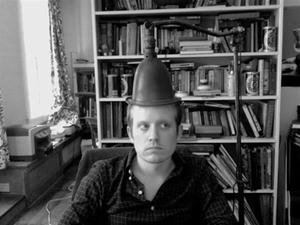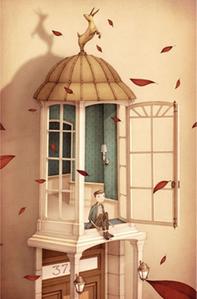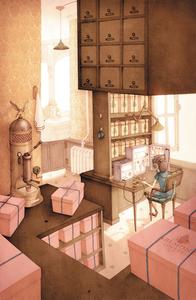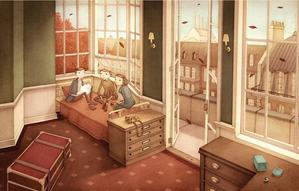 Nicholas Gannon makes his book debut with The Doldrums, the story of 11-year-old Archer Helmsley, who yearns to become an explorer like his famous grandparents, but whose mother confines him to their house. His blossoming friendship with two neighbors widens his world in unexpected ways. Gannon also illustrated the book in full color. Here he discusses the seeds of the project, which began with a drawing on a construction site (literally) in upstate New York. He lives in Brooklyn, N.Y.
Nicholas Gannon makes his book debut with The Doldrums, the story of 11-year-old Archer Helmsley, who yearns to become an explorer like his famous grandparents, but whose mother confines him to their house. His blossoming friendship with two neighbors widens his world in unexpected ways. Gannon also illustrated the book in full color. Here he discusses the seeds of the project, which began with a drawing on a construction site (literally) in upstate New York. He lives in Brooklyn, N.Y.
How did The Doldrums begin? With an image? A plot idea?
The Doldrums began with a sketch of Archer that I drew when I was working on a construction site in upstate New York. Almost immediately, I knew Archer as a boy who wanted adventure and wanted to do great things, but he was stuck. The original drawings are on the walls of that home. So I guess he'll always be stuck.

|
|
| Archer the dreamer | |
Did Archer come first, and then Oliver and Adélaïde?
I think Adélaïde came first, even before Archer did. I drew a little girl with knee-high socks, and one of them didn't look right, so I turned it into a wooden leg. And to make it more tragic, I made her a ballet dancer. So she had a back story, but Archer had a forward-looking story. With these two characters, I created the Doldrums Press. In this small little newspaper, I'd write about Archer and Adélaïde. It was out of that newspaper that the character of Oliver came.
I thought about a character who'd be reading these stories and who he'd be. I guess that character would be Oliver. That's why his father in the book is the editor of the Doldrums Press.
Tell us about the house. It becomes a character unto itself.
After I found a job back in the city and left the construction site, I rented the fifth floor of a brownstone on the Upper West Side, and it had a balcony. It was there that I started writing the Doldrums Press. I realized it was the perfect setting for Archer and Adélaïde. The house, which belonged to a former president's wife, was beautiful, filled with tons of old furniture and tapestries from the 1700s, and it belonged to this prestigious family. It helped me develop Archer and his family.
It also backed up to a courtyard with its own little garden. It was like the beginning of [C.S. Lewis's] The Magician's Nephew, where they go off to the magical place, but to me this is the magical place. I would have loved it as a kid, a place where I could hop over the wall to my friend's house and go up to the roof. I wanted it to be a contained world, where they could have a sealed-off secret place within a bigger city.
One of the big things about Helmsley House is all the taxidermied animals. That came in part from this place in Paris called Deyrolle Taxidermy, a crazy place, with animals and old moldings. It was fun to use for the story, and visually it was very beautiful.

|
|
| Adélaïde at the radio, in the back of her father's Belmont Café. | |
Let's talk about the animals. The animals talk to Archer, but you also leave it open that it might be just in Archer's mind (since only he can hear them).
When I was writing the Doldrums Press, there was one issue I'd done where Archer went through a dream sequence in an alternate animal world. He'd been invited to compete, and in the opening sequence, there's an image of him racing atop an ostrich. The animals can all talk, and they have a fun repartee back and forth.
Your artwork is so polished. Where did you get your training?
I went to Parsons School of Design here in New York City, but I also studied with some classical artists, including Michael Aviano, a painter on the Upper West Side. He had a little brownstone studio, and there were about eight of us who'd paint and draw on Fridays and Saturdays, for about 3-4 hours in the morning, and 3-4 hours after lunch. Between him and another classical person, I took from them the technique, which may contribute to the very realistic and polished quality of the art.
What is the medium in which you work? Is it watercolor?
It's all hand drawn, pencil on nice paper. I scan it at a really high resolution. I can understand why you'd say watercolor because I do these transparent layers of color, and the drawing's always coming through. I've always been horrified by paint. Whenever I'd paint, I'd see a blue dot had followed me all the way to the kitchen. So I like a nice sharp pencil. I use these architectural pencils, with which you get a slow buildup of value, and you can render it again and again and again to get it darker and darker. It alleviates what you'd expect to see from a pencil rendering. My fingers are constantly black because I'm rubbing and smoothing.
When I'm going in and coloring my drawings, I'm putting color over my stencil; I can increase the white and bring up the dark. I do render it dark, but when I bring it into the computer, I can render it white again. You don't have to worry about the permanence of watercolor--with the computer I can constantly and obsessively manipulate everything I'm doing.
There's a wonderful tension between Archer's parents. His father is more akin to his parents, the explorers, and his mother wants to keep Archer tethered to the house. Do you plan to explore this more in future books?
I try not to be aware of themes when I'm writing, but family [as a theme] became, to my surprise, the heart of the book. The dynamics of the family definitely change in the next book. I see Mrs. Helmsley as a character who married a man and got a lot more than she bargained for. Ultimately she has Archer's best interests at heart. Mr. Helmsley is much more of the mindset "Archer is going to be Archer," and he's fine with that.
Archer escapes the watchful eye of his mother; generally when we see Mr. Helmsley, Mrs. Helmsley is right there with him. The scene in Archer's bedroom is the only time we see Archer alone with his father.
 |
|
|
Archer, Oliver and Adélaïde make plans. |
|
Fathers figure prominently in the book, not just for Archer, but also for Adélaïde and Oliver.
I noticed that, too. It's not something I set out to do. The first book is the three dads and the three kids. Archer's a bit listless. For Archer, the grandfather is more the influence. Oliver Glub is not the exact opposite of his father, but his father's vocation as editor of the Doldrums Press has made him more who he is.
Tell us about the Society characters (the captain whom Archer calls the Eye Patch; the "crooked man" who bet against Archer's grandparents' return)--where did they come from?
The Society, in book two, plays a big role. In book one [The Doldrums], I thought it was important to hint at a much bigger world that Archer's grandparents are a part of. That creates some mystery for Archer because he's more intrigued by where his grandparents are.
The man with the eye patch and the crooked man take on a much bigger role in the next book, especially Mr. Birthwhistle and the Society (of which Birthwhistle is president). In the Society there are a lot of factions--not political--to Archer, his grandparents are wonderful, but every society has a dark, seedy underbelly.
A microcosm for society at large?
I can't comment on that.
There's a watershed moment when Oliver and Archer make a realization about Adélaïde, and they observe, "They needed Adélaïde to be who she wasn't." This is a theme that threads throughout the book (Archer needs his father to be someone he isn't; he needs his grandparents to be alive, and he's not sure if they are). Tell us about that.
For Oliver and Archer, they struggle with who they want to be versus who they are. Archer wants grand adventures and things that he believes, by merit of his family, he can be; and then he realizes he isn't. Though she lied about who she is, Adélaïde's exactly the person Archer needed her to be in order to become who he is. That quote is specifically relating to Adélaïde with the crocodiles and them with the tigers, but if Adélaïde had been who they thought she was, Archer couldn't have outrun a pack of tigers.
Do you think that children can discover a difficult truth about a friend and go on being friends?
I think it really depends on what that difficult truth is. Did he eat your cupcake or did he poison it? If he poisoned it, it's difficult to be friends--for whatever time you have left. That's really the point of friendship, the longer you go in a friendship, the more you learn about your friend. We all put our best face forward in the beginning, and that's for the best. If you knew everything from the beginning you might not be friends.
If Archer had known who Adélaïde was when they first met, they'd never have been friends in the first place. I think one of Archer's flaws is that in the beginning he's just looking at what they can give him--all of his relationships outside of the family are about achieving his own end. He starts to see Oliver and Adélaïde for who they are, like when they're running for the bus, and he realizes Adélaïde can't keep up and goes back for her. He's more obsessed with the myopic plan at the beginning and widens to "our" plan. --Jennifer M. Brown

